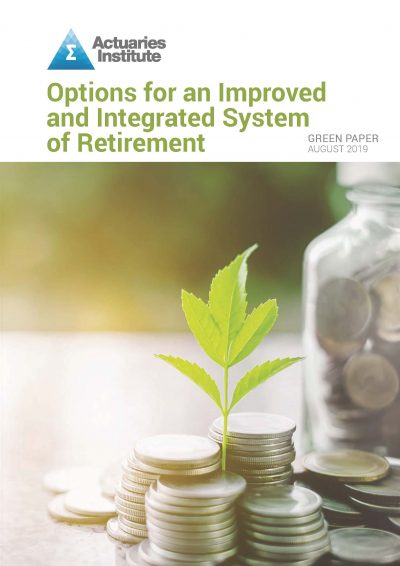
Designing an Improved and Integrated Retirement System for all Australians
Who says actuaries aren’t brave? They would surely be wrong given the bold discussion that three eminent actuaries are leading through the Institute’s latest Green Paper, Options for an Improved and Integrated Retirement System. The Institute paper, written by Anthony Asher, David Knox and Michael Rice, today put forward wide ranging potential reform options and sets out the case for why and how fundamental reform of Australia’s system of retirement can be done.
 To facilitate such a debate requires, first and foremost, top-down clarity of the objective of the retirement system, and knowledge of the longer-term trends that affect the capacity of the system and needs of its people.
To facilitate such a debate requires, first and foremost, top-down clarity of the objective of the retirement system, and knowledge of the longer-term trends that affect the capacity of the system and needs of its people.
The Green Paper suggests an ideal retirement system would integrate how the different income sources (the Age Pension, superannuation and other savings) support the known expenditure needs of older Australians (including health and aged care). Despite the compulsory superannuation system approaching its 30th birthday, there has been no attempt made in the national policy debate to define an objective for how the income sources should ‘fit together’. Nor has any sustained attempt be made to take a view which integrates income with expenditure needs for the retiree cohort.
The paper therefore proposes the overarching objective of the retirement system should be to ensure that Australians can confidently live their retirement with dignity.
However, such an ideal is difficult to measure and guide specific policy choices. Three principles have therefore been provided to help assess whether a system provides the conditions to achieve a dignified retirement:
- Financial security – The vast majority of Australian retirees should feel financially secure.
- Efficiency – The retirement system should be efficient in delivering the retirement income needs from both the consumers’ and Government’s perspectives.
- Fairness – The cost to government, and therefore taxpayers, of total retirement provision must be shared equitably between and within generations.
Ahead of the launch, Vanessa Beenders, Institute Practice Excellence Adviser, sat down with Anthony, Michael and David (remotely) to discuss the context of the paper. The four highlighted main reasons why the retirement system should be reformed and further discussed these options in the second episode of the podcast.

So, what sort of reform options would help Australian retirees live with dignity by providing financial security, and being efficient and fair? The paper sets out six main areas in order to stimulate a debate about meaningful reform.
A priority should be to simplify the Age Pension given the complexity that arises from having two means tests (unlike anywhere else in the world) with taper rates and various thresholds depending on an individual’s circumstances. Possibilities include having a single means-test (by deeming income from assets), making it universal (at least at a part-pension level) or removing the complications that arise from part-pensions by only having full pensions. This could be implemented by, for example, requiring a person to spend all or most of their wealth before they are eligible for a full pension or, alternatively, requiring them to ‘buy’ that portion of the full pension to which they are not otherwise entitled but would then receive. The Age Pension means testing regime could also be integrated with that for Aged Care support.
Another option is addressing the anomalies and perverse incentives that arise by exempting the family home from the Age Pension asset means test. As a result, ‘right sizing’ of homes in retirement years is discouraged, to the detriment of younger generations needing to accommodate larger households.
The distortion from this exemption has grown substantially over recent decades due to the strong relative growth in housing prices.
Drawing on core actuarial tools and reflecting reality, it also makes sense to consider embedding automatic adjustments to both the superannuation preservation age and Age Pension eligibility age as new life expectancy figures are published. This could depoliticise a highly sensitive issue. Readers may recall the fracas that followed the 2014 Budget when the then Treasurer announced a proposal to lift the pension eligibility age to 70, which was subsequently abandoned without explanation in 2018.
A practical way forward could be having the adjustment linked to improvements in life expectancy, but this need not be one-for-one. We also need a range of broader initiatives so older workers are genuinely supported in the workforce.
Other options are also explored. For example, should a target for government support of older Australians be set and help shape fiscal policy? Should taxation anomalies on large superannuation balances and bequests be addressed? Should the funding anomaly of refundable accommodation deposits (essentially short-term loans by unsophisticated and potentially vulnerable individuals to back long-term essential infrastructure) be tackled?
The realities are many of us will need to engage deeply with this topic soon enough, either for our parents or ourselves. For example:
- Over a third of people aged 60-64 years are retiring with mortgages and need to use their superannuation to either service or extinguish that debt before they can think about using it to fund their other living expenses.
- A greater proportion of the population is expected to live well into their mid to late 80s or beyond, meaning the number of years in retirement that need to be funded have grown substantially compared with previous generations.
- Based on current life expectancy (and not allowing for any further improvements), the lifetime risk for a 65 year old of entering permanent residential aged care, and dealing with refundable accommodation deposits and the many other complexities of the aged care system, is over 40% for men and nearly 60% for women.
The Government is expected to announce a comprehensive review of the retirement income system shortly. We encourage the national debate to be equally bold such that what emerges from it will be a much improved system and one that is ‘fit for purpose’ for many years to come.
For a further discussion of these ideas, as well as other aspects covered in the Green Paper, readers can listen to the podcasts with Anthony, David and Michael. The Institute and authors welcome feedback on the best way forward. Please send comments to actuaries@actuaries.asn.au.
CPD: Actuaries Institute Members can claim two CPD points for every hour of reading articles on Actuaries Digital.






